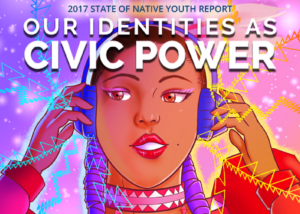 April 2018
April 2018
Products of NAPTAC
Native American Parent Technical Assistance Center
Summary by Norrine Smokey-Smith
- 3-page Brief in Word
- 2-page Brief in PDF
- 2-page Infographic in PDF
- Visit the Native American Resource Collection
_____________________
 At A Glance
At A Glance
These NAPTAC products summarize the findings of 2017 State of Native Youth Report: Our Identities as Civic Power, from the Center for Native American Youth (CNAY). NAPTAC is pleased to summarize the report’s findings in three easy-to-read ways: as a 3-page accessible brief in Word; as a 2-page brief in PDF; and as a 2-page infographic in PDF.
This summary will support Parent Centers in:
- working with youth with disabilities who are American Indian/Alaska Native (AI/AN);
- understanding what Native youth have identified as the major issues facing young people in their community;
- expanding outreach to and relationships with Native communities;
- adapting youth-oriented trainings to include Native voices that will resonate with AI/AN youth.
_____________________
About the Report
Title | 2017 State of Native Youth Report: Our Identities as Civic Power
Author | Center for Native American Youth (CNAY)
Full Report Online | http://www.cnay.org/blog/native-american-youth-our-identities-as-civic-power
_____________________
Background
In 2016 the Center for Native American Youth (CNAY) conducted a national Generation Indigenous Online Roundtable Survey of Native youth to gain deeper understanding of the resources needed to reduce barriers to their success. Native youth nationwide were asked to name the major issues facing young people in their community. Their answers are outlined in the 2017 State of Native Youth Report: Our Identities as Civic Power.
Becoming aware of and implementing the findings in this report can significantly reduce the numbers of Native youth who are neither in school nor working (called “opportunity youth”)—and promote their increased well-being and educational success.
Issues that Matters Most to Native Youth
Fifty-eight percent (58%) of survey respondents identified culture and language as the top priority needing attention in their communities. Other key issues include education (43%), getting employed or preparing for employment (35%), and mental and emotional health (33%).
Culture and Language
In addition to being U.S. citizens, American Indian/Alaska Native (AI/AN) youth are also citizens of tribal nations and, as such, are the future leaders of their tribal cultures, traditions, and governments. Supporting the preservation of Native cultures is critical to maintaining their unique tribal identities, traditions, and ideals. Culture and language are also central to engaging youth and helping find solutions to problems in their communities.
A key finding for increasing Native youth success is connectedness to one’s tribal culture. Native youth draw strength from their culture; it is a valuable protective factor. Other Native-specific protective factors include spirituality, plus the closeness of family and friends. Each promotes well-being and can also guide prevention efforts that reduce barriers to Native student achievement.
Efforts to revitalize Native languages must be expanded beyond tribal communities into school classrooms through language immersion programs. Integrating Native history and culture into academics will also enhance Native students’ educational engagement and outcomes, and can reduce the number of AI/AN student disciplinary actions.
Education
Nationwide, 93% of AI/AN youth attend public schools. It’s been well noted that, in school, they are often more harshly disciplined than other students—for example, Native boys with disabilities have the second highest rate of out-of-school suspensions. Many Native youth feel invisible and unsafe in their schools, alienated from both teachers and their peers. Like other youth of color, Native students struggle in schools that, for many, are more of an early gateway into the criminal justice system than a place to learn.
Schools must become safer and more supportive of Native youth. Survey respondents report the greatest need is to educate non-Natives about Native culture. Including culturally relevant curricula can help counter racist attitudes and negative stereotypes that Native students often encounter. In addition, providing opportunities in school for AI/AN youth to share their tribal cultures and support one another can positively impact school climate and reduce school push out. The core of improving educational outcomes for AI/AN youth is promoting Native values.
Employment
One in four Native youth between the ages of 16-24 are “opportunity youth,” neither going to school or work. AI/ANs have the highest unemployment rate of any race or ethnic group in the country—twice the national average. Survey respondents indicated the following economic resources are needed:
- more jobs for young people in their communities,
- greater access to high-speed internet,
- financial literacy programs, and
- transportation to after-school programs.
Programs such as cradle-to-career pathways curb dropouts and youth unemployment. Culturally-grounded summer intern programs and tribal partnerships with colleges provide pathways and training for professions needed in tribal communities. The combination of culture, education, and career success was at the core of the Online Roundtable Survey findings.
Mental and Emotional Health
Historical and intergenerational trauma is a major factor contributing to mental health issues among AI/AN populations, which is amplified by depression and substance abuse. Survey respondents identified suicide—the second leading cause of death among AI/AN youth between the ages of 10-34—as a critical issue. The opioid crisis is another major challenge. Native youth have the highest rate of opioid overdoses than any other ethnic group.
Seventy-one percent of survey respondents substantiated that culturally appropriate and traditional healing practices—access to sweat lodges, smudging, and intergenerational dialogues—as well as peer support groups are valuable aids to battling mental health challenges. They also identified the need for more culturally appropriate mental health services, peer support groups, suicide prevention programs, and suicide intervention training.
Suggestions for Parent Centers
Check out NAPTAC’s infographic on the CNAY report, which condenses its findings in an easy-to-read-and-share format.
Incorporate CNAY’s findings—in essence, the voices of today’s Native youth—into your Parent Center activities, materials, and training sessions.
Learn about promising practices that promote educational engagement and outcomes among Native youth. These will inform your outreach efforts to AI/AN parents and youth with disabilities as well as support your direct work with Native families.
Share this brief and the infographic broadly, especially with schools and at Parent Center trainings for parents of Native youth with disabilities and at exhibit booths in AI/AN communities.
Advocate for Native students in school meetings and planning groups in which your Parent Center is involved. Especially emphasize how the findings of the CNAY report illuminate the need for schools to include accurate information about Native history and culture in the curriculum that all students study.
NAPTAC Note
NAPTAC is the Native American Parent Technical Assistance Center, funded by the Office of Special Education Programs (OSEP) at the U.S. Department of Education. We work with the network of Parent Centers around the country to support the training and information they offer to Native American and Alaska Native parents whose lives are impacted by disability. This document was produced under U.S. Department of Education, Office of Special Education Programs No. H328R130012-14. The views expressed herein do not necessarily represent the positions or policies of the Department of Education. No official endorsement by the U.S. Department of Education of any product, commodity, service, or enterprise mentioned in this publication is intended or should be inferred. This product is in the public domain. You are free to copy and share it, giving the citation as:
Smokey-Smith, N. (2018, April). What’s important to Native youth? Albuquerque, NM: Native American Parent Technical Assistance Center (NAPTAC).
________________________________________________________
 **Highly Rated Resource! This resource was reviewed by 3-member panels of Parent Center staff working independently from one another to rate the quality, relevance, and usefulness of CPIR resources. This resource was found to be of “High Quality, High Relevance, High Usefulness” to Parent Centers.
**Highly Rated Resource! This resource was reviewed by 3-member panels of Parent Center staff working independently from one another to rate the quality, relevance, and usefulness of CPIR resources. This resource was found to be of “High Quality, High Relevance, High Usefulness” to Parent Centers.

